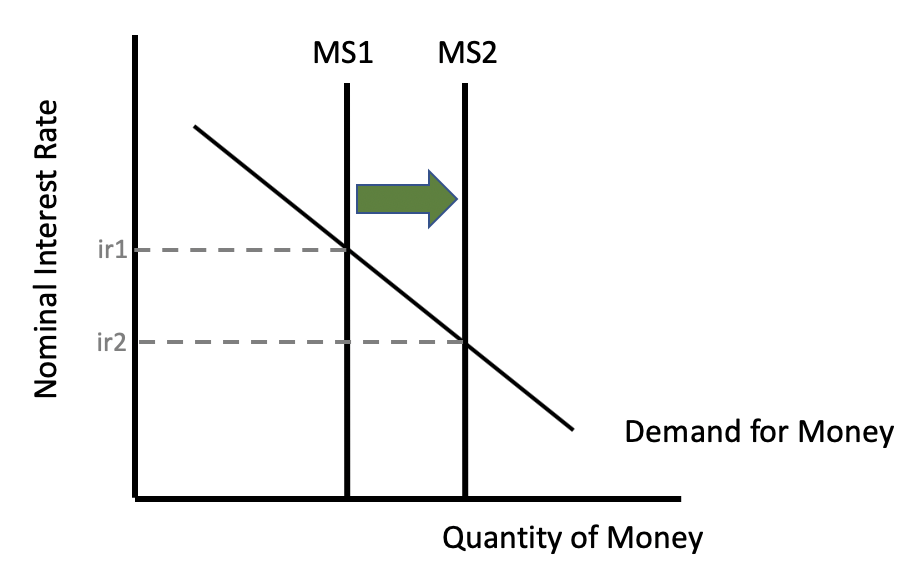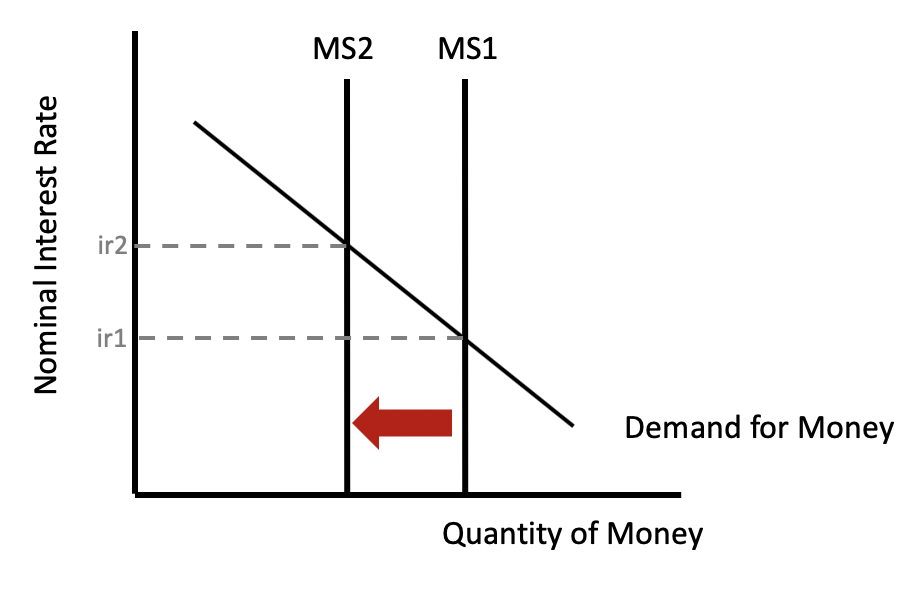The Federal Reserve's main goals in managing our nation's money supply are the exact same goals as the federal government's in fiscal policy, which is to promote the following:
In this tutorial, we will focus on the actions of the Fed versus the federal government.
Today we will be discussing monetary policy, which is typically policy set by a central banking authority, whereby money supply access and the interest rate is varied to assist in stabilizing economic activity.
The Fed has different tools than the federal government does. The FOMC is part of the Federal Reserve and they meet eight times a year to manage our nation's money supply. The tools used by the FOMC include:
Let's start our discussion with the reserve requirement.
That reserve requirement is the required amount of depository liabilities as set by the Fed that a bank must hold, typically quoted as a percentage (e.g., 10%).
It is important to remember that the fact that banks can lend out a portion of customer deposits makes it possible for them to create money in our economy. This point is essential for understanding today's lesson on expanding or contracting the money supply, which we will cover later in the tutorial.
Now, it is the money multiplier that actually calculates the amount that the money supply can increase through banks' ability to loan funds.
The money multiplier is the increase in the money supply resulting from the ability of banks to loan deposits. Its value is equal to 1 divided by R, where R is the reserve ratio.

EXAMPLE
Using the example of a 10% reserve requirement, expressed as .10, you can see that the multiplier becomes 10.Therefore, you can see that as we raise and lower the reserve requirement, it either makes the multiplier bigger or smaller.
If we lower the reserve requirement, this makes the multiplied effect, or the impact that banks could have on the money supply through their loaning, much greater. Conversely, if we raise the reserve requirement, it lessens this ability, because the multiplier would be smaller.
The fed funds target rate, then, is the rate that Fed member banks charge other member banks for overnight loans, typically made to meet reserve requirements.
Now, if banks need to borrow from the Fed itself to meet their short-term liquidity needs, they would pay the discount, or window rate, to the Fed itself.
So, what does the Fed do when the economy is in a recession? Well, let's examine what happens during a recession.
During a recession, economic activity is slowing, as measured by real GDP. Often, consumers and businesses are not spending as much money due to low confidence in the economy.
EXAMPLE
If consumers are not confident in the economy, they might exhibit behaviors like putting off a summer vacation and saving the money instead, in case they lose their jobs. Likewise, they might choose to eat in this weekend instead of the usual restaurant meal out--again, saving that money.Now, how do these behaviors impact the money supply? Well, when a consumer decides not to go out to eat this weekend, it does not just impact that consumer. It also reduces the amount of money the restaurant is making. In turn, that restaurant has less money to pay its workers, and those workers are then less likely to make purchases somewhere else.
As you can see, this has a multiplied effect in the economy--specifically, a multiplied negative impact in the economy.
So, how does this impact the money supply? Well, when consumers and businesses are not spending as much money or as frequently, it can reduce the size of M1.
There is now a risk for deflation since people are tending to hold onto money and save it, keeping it in the banks.
Therefore, in order to reduce this risk and get people spending money again, the Fed can enact expansionary monetary policy, by increasing the money supply. This is also known as an easy money policy.
Expansionary policy is either monetary or fiscal policy--here, we are focusing on monetary--that is enacted to stimulate economic growth.
In other words, it aims to get the economy moving again, and it achieves this by enticing people to take money out of the banks and spend it.
There are several actions that the Fed can take:
Essentially, all of these policies work in the same way, but through slightly different tools.
Now, this is what it looks like when the Fed enacts easy money policy. When they increase the money supply, it will lower interest rates throughout the economy.

At lower rates, people and firms tend to take advantage of the lower rates by taking out loans for items like homes and cars. This is what has an expansionary effect on the economy.
Another way to think about this is when the Fed increases the money supply, essentially they are creating a little inflation. Now, this might sound like a bad thing, but the idea is since the purchasing power of money is falling, people will want to spend money sooner rather than continuing to hold onto it. During a recession, a little inflation is not necessarily negative, because generally, inflation is very low during a recession.
EXAMPLE
During the housing crisis of 2007 to 2008, our Fed took many measures to ensure that banks would not fail and could continue to make loans. First of all, they purchased billions of dollars of Treasury and other securities, called credit easing. They drove the discount rate way down, essentially allowing member banks to borrow money from the Fed for free.Now let's discuss the opposite situation when there is inflation in the economy.
During a rapid expansionary period, economic activity is growing. Consumers and businesses are spending a lot of money--and very quickly--due to high confidence and prosperous economic times.
EXAMPLE
When consumer confidence in the economy is high, they might make choices such as definitely taking that summer vacation, or going out to dinner instead of eating in.When people are making these kinds of decisions, like eating out, this is increasing the amount of money the restaurant is making. In turn, the restaurant pays its workers, and those workers can go on to make purchases elsewhere. This has a multiplied positive effect on the economy.
However, this shows that when consumers and businesses are spending a lot of money, it increases the size of M1, leading to a risk for inflation. People are not holding onto money and it is changing hands very quickly.
Now, a little inflation is fine. However, it is possible for the economy to get overheated.
Sometimes, when that risk is high, the Fed will step in and enact contractionary monetary policy to try to slow down an overheated economy.
In this situation, the Fed will do all the opposite things and decrease the money supply. This is known as a tight money policy. Contractionary policy is a monetary or fiscal--in this case, monetary--policy that is enacted to slow economic growth.
Contractionary policy aims to slow down the economy. It can achieve this by enticing people to keep money in the banks and spend less.
The Fed can do this by taking the following actions:
When we enact tight money policy, it decreases the money supply and raises interest rates in the economy.

At higher rates, people and firms tend to keep money in the banks and take out fewer loans. This has a contractionary or slowing effect on the economy.
EXAMPLE
In the late 1970s and early 1980s, our economy experienced significant, double-digit inflation. The Fed sold securities and raised rates in an attempt to contract the money supply and slow down the rate of inflation.Source: Adapted from Sophia instructor Kate Eskra.